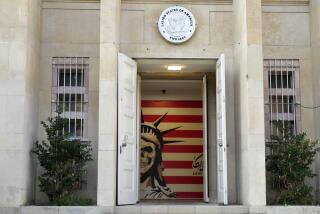Burning of Ayatollah Khomeini’s picture sparks uproar in Iran
- Share via
Reporting from Tehran — Political turmoil built Sunday over the burning of an image of Iran’s revolutionary founder, which was aired, in a controversial move, on state television. Accusations that the incident was carried out by anti-government demonstrators sparked protests as well as threats against reformist leaders.
Iran’s supreme leader Ayatollah Ali Khamenei on Sunday said reformist politicians and anti-government demonstrators had defiled the image of his predecessor, Ayatollah Ruhollah Khomeini, during National Students Day protests last week. He said the incident showed that the protest movement that sprang out of the disputed reelection of President Mahmoud Ahmadinejad now sought to overturn the government.
Opposition supporters, however, said the incident was staged by hard-liners loyal to Ahmadinejad and aired on TV to discredit the opposition’s cause.
Tensions rose as police surrounded Tehran University, a hotbed of political activism, where students staged a protest rally Sunday to convey their stand that they were not behind the burning.
The official Islamic Republic News Agency said protests also broke out on other Tehran campuses. News agencies reported that Zahra Rahnavard, the wife of opposition leader Mir-Hossein Mousavi, addressed the students.
Seminary students across the country on Saturday demonstrated against the burning of Khomeini’s image. And 232 lawmakers supported a statement condemning the burning and praising state television for broadcasting the image.
Khamenei blamed reformist leaders for the incident. “They did their best to encourage people to confront the establishment, although they had not the power to finish the job,” he told a group of clerics in a speech broadcast on state television.
Khamenei said enemies of the late Ayatollah Khomeini were “so encouraged that they came to the university and insulted the imam’s picture.”
The airing of the footage could harm the protest movement, painting participants as bent on overthrowing the government. But the move also risks legitimizing radical opponents of the system whose stance rarely gets a public airing.
Khomeini’s grandson, Hassan, a mid-ranking cleric, criticized state television for airing the footage, rather than the protesters for purportedly burning the image.
Iran is undergoing its worst political crisis in decades in the wake of the disputed presidential election, in which Ahmadinejad defeated reformists Mousavi and Mehdi Karroubi and conservative Mohsen Rezai amid charges of vote-rigging. Over the weekend, Mousavi’s website, Kaleme.com, and other reformist news outlets warned of his imminent arrest. But others say such fears are exaggerated.
“I do not think the system dares to arrest Mousavi or Karroubi, as it may lead to an explosion,” said Mashallah Shamsolvaezin, a newspaper writer and reformist political analyst.
The supreme leader called on authorities to find out who was behind the burning of the picture but also asked security forces to remain calm. “It is not expedient to spread tension, riot and discord into society, because it is what the enemy wants,” he said.
Mostaghim is a special correspondent.
More to Read
Sign up for Essential California
The most important California stories and recommendations in your inbox every morning.
You may occasionally receive promotional content from the Los Angeles Times.










